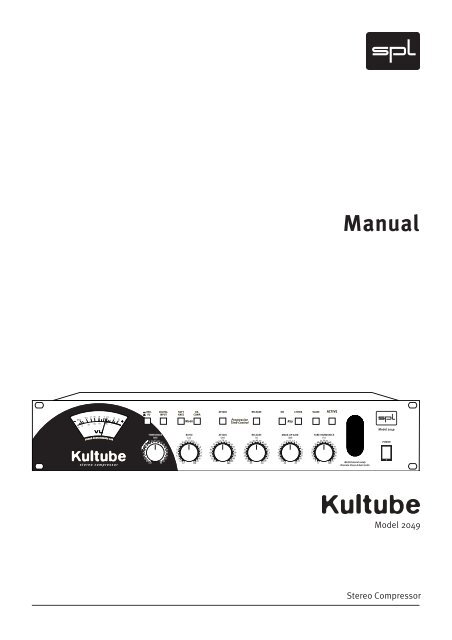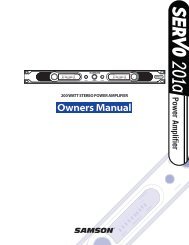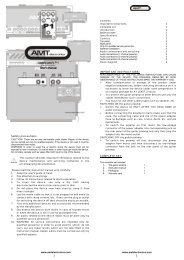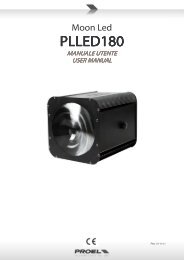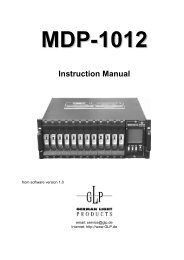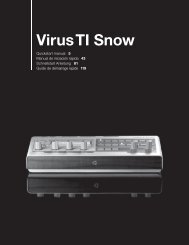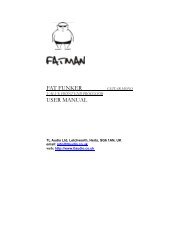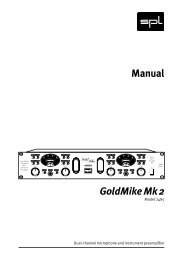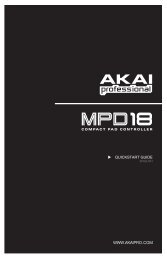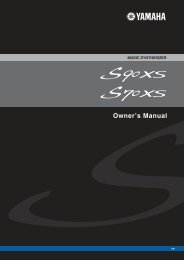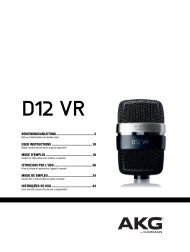Kultube
Kultube
Kultube
Create successful ePaper yourself
Turn your PDF publications into a flip-book with our unique Google optimized e-Paper software.
Manual<br />
Model 2049<br />
Stereo Compressor
<strong>Kultube</strong> (Model 2049)<br />
Version 1.1 – 11/2004<br />
R & D: Ruben Tilgner<br />
Manual<br />
The information in this document has been carefully verified and is assumed<br />
to be correct. However Sound Performance Lab (SPL) reserves the right to<br />
modify the product described in this manual at any time. Changes without<br />
notice. This document is the property of SPL and may not be copied or reproduced<br />
in any manner, in part or full without the authorization of SPL.<br />
Limitations of Liability:<br />
In no event will SPL be liable for any damages, including loss of data, lost<br />
profits, cost of cover or other special, incidental, consequential or indirect<br />
damages arising from the use of the unit, however caused and on any theory<br />
of liability. This limitation will apply even if SPL or an authorized dealer has<br />
been adviced of the possibility of such damage.<br />
Sound Performance Lab<br />
SPL electronics GmbH<br />
P.O. Box 12 27<br />
D- 41368 Niederkruechten, Germany<br />
Phone +49 - 21 63 / 98 34 0<br />
Fax +49 - 21 63 / 98 34 20<br />
eMail: info@soundperformancelab.com<br />
www.soundperformancelab.org<br />
© 2004 SPL electronics GmbH. All Rights Reserved.<br />
2
Content<br />
Introduction .............................................................................................. 4<br />
Particular Feature, Equipment ................................................................... 4<br />
Hookup & Security Advices ........................................................................ 5<br />
Power Supply ............................................................................................ 5<br />
Connections<br />
Rear Panel/Wiring ..................................................................................... 6<br />
General Advices, Sockets & Switches ........................................................ 7<br />
Control Elements<br />
Red. /VU, Digital Input, Softknee, De Comp. ............................................. 9<br />
PTC-Attack, PTC-Release, Key On, Key Listen, Slave, Active ....................... 9<br />
Threshold, Ratio, Release, Make Up Gain .................................................. 11<br />
Tube Harmonics ......................................................................................... 12<br />
Operation – Understanding and enjoying the <strong>Kultube</strong><br />
The Threshold Control ............................................................................... 12<br />
The Ratio Control ....................................................................................... 13<br />
The Attack Control ..................................................................................... 14<br />
Progressive Time Control – Attack ............................................................. 15<br />
The Release Control ................................................................................... 16<br />
Progressive Time Control – Release ........................................................... 17<br />
Applications – Using and enjoying the <strong>Kultube</strong><br />
Summed Signal Processing ....................................................................... 19<br />
Single Track & Subgroup Processing .......................................................... 19<br />
Sidechain .................................................................................................. 20<br />
Multi Channel and 5.1 SurroundProcessings .............................................. 21<br />
Specifications ............................................................................................ 22<br />
Warranty .................................................................................................... 23<br />
Your Notes ................................................................................................. 24<br />
3
Introduction<br />
The <strong>Kultube</strong> is an extremely versatile compressor with a broad range of<br />
control facilities that cover all typical compressor applications. From improved<br />
stereo mixes in the “MIDI Studio“ to surround mastering with several devices<br />
connected, all jobs can be undertaken to the highest degree of sound quality.<br />
You can, for example, choose between the hard and soft-knee characteristic<br />
and insert external devices via a side-chain input for external control. With the<br />
unique “Progressive Time Control“ for attack and release, time constants can<br />
be optimised by unique circuitry that reacts both to the input signal and to the<br />
user settings - for example, fast impulses are intercepted by an attack time as<br />
fast as 20 us. In master/slave mode, any number of devices can be controlled<br />
from one master unit.<br />
The adjustable tube saturation of the output stages combined with automatic<br />
output level adjustment can produce tube sound effects that range from<br />
the delicate to the raucous whilst a useful decompressor mode can reanimate<br />
overcompressed material (such as samples). The <strong>Kultube</strong> user has a unique<br />
range of powerful compression tools always available, from subtle unobtrusive<br />
compression to very obvious ‘effect‘ compressions - it‘s all possible.<br />
Used conventionally or as an effect, in the MIDI and project studio or in the<br />
professional studio, the <strong>Kultube</strong> delivers outstanding audio quality with SPL‘s<br />
acclaimed musicality and user-friendliness.<br />
Applications cover those of a classic compressor for vocals and instruments,<br />
in both mono and stereo, through to stereo operation for subgroup processing,<br />
stereo mastering, multi-channel or surround projects.<br />
Particular Feature<br />
SPL has developed discrete, very high performance gain cells that are used<br />
instead of the usual VCAs and the <strong>Kultube</strong> is the first product to use them.<br />
They ensure the highest level of musicality and clarity in signal processing<br />
and demonstrate significantly improved distortion values over VCAs.<br />
Equipment<br />
• “Progressive Time Control“: user optimization of attack and release times<br />
that work in conjunction with the unit‘s signal responsive circuitry to provide<br />
the best attributes of manual and auto compressors at the same time<br />
• Adjustable tube saturation with output level adjustment<br />
• Selectable soft or hard knee characteristics<br />
• Unique decompression mode<br />
• Large VU meter displays gain reduction or (mono summed) output level<br />
• Switchable side-chain inputs on the front panel<br />
• Slave mode for multi-channel operation<br />
4
Carefully select a place for setting up the <strong>Kultube</strong>. The unit should be situated<br />
away from heat sources and direct sunlight. Avoid installation in environments<br />
exposed to vibrations, dust, heat, cold or moisture. Keep the unit away from<br />
transformers or motors or any other unit that could generate large variations<br />
in power supply or cause electrical interferences. Do not install the unit in<br />
proximity to power amplifiers or digital processors. You may consider placing<br />
it in a rack containing other analog gear. Such placement can prevent interference<br />
from Word Clock, Smpte, MIDI, etc.<br />
• Do not open the case. You may risk electric shock and may damage your<br />
equipment.<br />
• Leave repairs and maintenance to a qualified service technician. Should<br />
foreign objects fall inside the case, contact your authorized dealer or support<br />
person.<br />
• To avoid electric shock or fire hazards do not expose your unit to rain or<br />
dampness.<br />
• In case of lightning unplug the unit. Please unplug the cable by pulling on<br />
the plug only; never pull on the cable.<br />
• Never force a switch or knob.<br />
• To clean the case use a lint-free cloth. Avoid cleaning agents as they may<br />
damage the chassis. Manufactured in standard 19“ EIA format, it utilises<br />
two rack units.<br />
• Please support the back of the unit whenever it is being mounted into a<br />
19 inch rack (especially important when touring).<br />
Built around a torroidal transformer, the power supply allows for a minimal<br />
electromagnetic field with no hum or mechanical noise. The power supply‘s<br />
output side is filtered by an RC circuit to extract noise and hums caused by<br />
your power service. 6000 µf capacitors smooth out the positive and negative<br />
half waves. An additional power supply filter is placed before the power switch<br />
to eliminate disturbing influences.<br />
All signal processing components are supplied with two separate current<br />
regulators to exclude influences from the remaining components.<br />
The 220 v current for the tube stage power is smoothed out with 200 µF<br />
and stabilized precisely by current regulators. A current limiting ensures a<br />
sparing warm up phase. The anode current is switched on after warm up. Both<br />
measures ensure a remarkable extension of the tube‘s lifetime.<br />
The supply voltage can be set to 230 V/50 Hz or 115 V/60 Hz. Check your<br />
country‘s power requirements for the appropriate setting. An AC power cord<br />
is included to feed the IEC-spec, 3-prong connector. Transformer, AC cord and<br />
IEC-receptacle are VDE, UL and CSA approved.<br />
The main fuse is rated at 315 mA for 230 v and 630 mA for 115 v.<br />
Chassis ground and AC ground can be physically disconnected with the<br />
“GND Lift” switch on the rear panel to eliminate hums.<br />
Hookup & Security Advices<br />
Power Supply<br />
5
Connections<br />
Rear Panel/Wiring<br />
2 1<br />
3<br />
Pin wiring XLR Input:<br />
1=GND 2=Hot (+) 3=Cold (-)<br />
Further <strong>Kultube</strong>s<br />
as slaves in multichannel<br />
link mode<br />
1 2<br />
3<br />
The <strong>Kultube</strong> can optionally be equipped with a 24 bit/96 kHz converter module<br />
Connector for external<br />
processing units (e. g.<br />
Equalizer)<br />
Connection to console:<br />
Insert Sends > Analog Inputs<br />
Insert Returns > Analog Outputs<br />
Pin wiring XLR Output:<br />
1 = GND 2 = Hot (+) 3 = Cold (-)<br />
Pin wiring Stereo Jack Connector:<br />
Tip = Hot (+) Ring = Cold (-) Sleeve = GND<br />
6
General Advices<br />
Connections<br />
Again, while <strong>Kultube</strong>‘s housing is EMV-proof and protects against<br />
HF-interference, placement of the unit is very important since it amplifies<br />
microphone signals as well as other unwanted signals. Before connecting the<br />
<strong>Kultube</strong> or any other equipment turn off all power. Adjust the voltage setting<br />
on the back so that it corresponds with the power conditions.<br />
The following graph shows the correct wiring for connecting unbalanced<br />
signals to the balanced XLR connectors:<br />
Input<br />
Output<br />
balanced unbalanced balanced unbalanced<br />
2<br />
1<br />
2<br />
1<br />
1 2<br />
1 2<br />
3<br />
3<br />
3<br />
3<br />
1=GND<br />
2=hot (+)<br />
3=cold (-)<br />
Alternatively unbalanced signals can be connected with mono Jack connectors<br />
to the balanced Jack sockets.<br />
Sockets & Rear Switch<br />
Connections<br />
Analog XLR and RCA jacks<br />
Symmetrical XLR and RCA jacks are used for analog in- and outputs. An analog<br />
mixing console is generally connected here (Insert Send/Return). Since the<br />
RCA and XLR jacks are wired in parallel, unbalanced operation of the RCA<br />
jack will have the same effect on the XLR jack and vice-versa. The <strong>Kultube</strong> is<br />
configured for a nominal level of +4dBu and can handle an input level of max.<br />
25 dBu, with max. +23 dBu available on the output. It is recommended to drive<br />
the <strong>Kultube</strong> with a signal level of between 0 dBu and 12 dBu – this being the<br />
optimum drive range for signal processing in which also the signal-to-noise<br />
ratio is the best.<br />
7
Connections<br />
Sidechain inputs<br />
Sockets & Rear Switch<br />
This jack is used as a sidechain input for connecting an external audio signal<br />
to control the <strong>Kultube</strong> (e. g. an equalizer for frequency dependent processing).<br />
It is configured as a stereo RCA jack, with the left channel on the tip and the<br />
right channel on the ring.<br />
Ideally you should use a normal insert cable that combines a stereo RCA plug<br />
(connected to the <strong>Kultube</strong>) and two mono RCA plugs (connected to the control<br />
device). When using an equalizer you can connect its inputs to the unused<br />
jack inputs on the <strong>Kultube</strong>. In this way both the equalizer and the <strong>Kultube</strong> get<br />
the same signal, since the XLR and RCA jacks are wired in parallel.<br />
To use the sidechain input, activate the KEY ON switch on the front panel. To<br />
monitor the signal, activate the KEY LISTEN switch. For other notes on using<br />
the sidechain function, see the section on page 20.<br />
Multi Channel Link<br />
The MULTI CHANNEL LINK jacks can be used to connect multiple <strong>Kultube</strong> units<br />
for multi-channel operation, so that they can be used together with a master<br />
unit. Before connecting the link cable, determine which is the master unit and<br />
connect the link cable to the MASTER jack. All linked devices are connected<br />
only through the SLAVE jack.<br />
CAUTION – NOTE WARNING: Always define only one master device! Never<br />
connect more than one device through the MASTER jack – otherwise components<br />
may be destroyed!<br />
After you have made the cable connections, the SLAVE switch on the front<br />
panel of each slave unit must be activated. From now on all functions of all<br />
slave units are controlled by the master.<br />
See page 21 for additional information about multi-channel operation.<br />
Hum? Ground Lift!<br />
Hum can be eliminated with the GND/LIFT switch on the rear of the unit<br />
(isolates the internal ground from chassis ground). Hum can occur for example<br />
when the <strong>Kultube</strong> is connected to devices having a different ground potential.<br />
Hum problems can also be avoided however by consistently installing balanced<br />
wirings. For this reason the GND lift function is by default not activated.<br />
8
Switches<br />
Control Elements<br />
Please note also the information on various controls under „Understanding<br />
and enjoying the <strong>Kultube</strong>“ starting page 12.<br />
RED/VU<br />
This switch changes the VU meter over to Gain Reduction mode. The indicator<br />
needle then jumps to the 0 dB value and moves to the left with increasing<br />
compression. The scaled values now refer to gain reduction.<br />
If the RED/VU switch is not pressed, the VU meter indicates the output<br />
level.<br />
If neither the RED/VU nor the ACTIVE switch is pressed, the VU meter indicates<br />
the input level. In Slave mode gain reduction is controlled by the master<br />
device.<br />
DIGITAL INPUT<br />
With the optionally available digital converter module you can use the DIGITAL<br />
INPUT switch to select the converted digital signals as an input source for<br />
the <strong>Kultube</strong>. The converter module thus adds digital in- and outputs to the<br />
<strong>Kultube</strong>, allowing it to be easily integrated into a digital production chain.<br />
SOFTKNEE<br />
SOFTKNEE alters the slope of the compressor. Normally the unit operates in<br />
hardknee mode, but pressing the SOFTKNEE switch places the unit in softknee<br />
mode.<br />
Softknee provides generally less conspicuous and softer compression<br />
results; the greatest possible loudness however can only be achieved in hardknee<br />
mode. The slope of the curves is shown on page 13.<br />
DE-COMP:<br />
This switch activates Decompression mode. This mode causes the compressor<br />
to work in reverse: All signals above the preset threshold become louder, and<br />
the Ratio controller determines the intensity of the volume increase. Please<br />
note that the Make-Up controller now works exactly in reverse: the signal<br />
becomes softer when the controller is turned to the right and louder when<br />
turned to the left.<br />
9
Control Elements<br />
Progressive Time Control: ATTACK<br />
Switches<br />
This function allows to switch in an adjustable automatization of the time<br />
constants which is set up with the ATTACK control.<br />
Put simply you can now influence the compression intensity for rapid signal<br />
increases, or when the function is turned off determine the time until a certain<br />
compression level is reached.<br />
Progressive Time Control: RELEASE<br />
The release times can also be switched to automatic based on the Release<br />
control: the latter then determines an average value to return the release to.<br />
Use of the Progressive Time Control is especially recommended with complex<br />
summed signals.<br />
KEY ON<br />
KEY ON allows you to use an external signal as the control source for the<br />
compressor.<br />
This signal is brought in to the SIDECHAIN INPUT jack on the rear of the unit.<br />
Now the control activity of the compressor is determined only by the external<br />
signal.<br />
KEY LISTEN<br />
Use the KEY LISTEN switch to monitor the external sidechain signal. This<br />
makes it easy for example to monitor and adjust a connected equalizer.<br />
Whereas the VU meter normally indicates the in- and output level, enabling<br />
KEY LISTEN causes the meter to indicate the sidechain signal. This provides a<br />
quick way to check also whether a signal is present.<br />
SLAVE<br />
This allows you to switch the <strong>Kultube</strong> to Slave mode so that it can be controlled<br />
from the Master device. All the function except for TUBE HARMONICS are now<br />
controlled by the Master. Both the Master and all the Slave units now get the<br />
same control signal. Also the Slave unit signals are evaluated for analysis.<br />
ACTIVE<br />
The ACTIVE switch turns on the <strong>Kultube</strong>. If the device is not turned on, the<br />
input signal is fed directly to the output jacks via a relay hard bypass. The<br />
ACTIVE switch thus allows for a quick A/B comparison. When the <strong>Kultube</strong><br />
is turned on the LED on the ACTIVE switch flashes to indicate the warm-up<br />
process for the tubes. The unit is ready when the LED no longer flashes.<br />
10
Controls<br />
THRESHOLD<br />
The Threshold control determines the compressor threshold value. The value<br />
scale for the THRESHOLD control indicates the level in dBu. Turning fully CCW<br />
provides no control, and fully CW provides compression starting at a level of<br />
approx. –40 dBu.<br />
Control Elements<br />
RATIO<br />
The RATIO control is used to set the ratio between the original signal and the<br />
compressed signal. A ratio of 1:4 means that a level increase of 4 dB on the<br />
input results in an output change of 1 dB. The more the control is turned CW,<br />
the more ‘dense’ the sound becomes. Turned fully CW the unit works as a<br />
limiter.<br />
ATTACK<br />
The Attack control determines the time the compressor needs to achieve<br />
a reduction of 63% at a level jump of 20 dB. When turned fully CCW this<br />
time is approx. 100 ms, and turned fully CW the time is approx. 0.9 s. When<br />
Progressive Time Control is enabled the effect is somewhat different: now you<br />
are determining the degree to which the fast signal jumps are compressed,<br />
whereas the attack time is automatically optimized (adapted). Progressive<br />
Time Control mode is often advantageous , since the attack time is only as<br />
fast as is necessary for the respective signal. The result is considerably unobtrusive<br />
and thus more musical compression behavior without undesired sideeffects.<br />
RELEASE<br />
The RELEASE control is used to set the time the compressor needs to back off<br />
by 63% to the original value. Turned fully CCW this time is approx. 30 ms, or<br />
approx. 2 s for fully CW. If Progressive Time Control is enabled, the Release<br />
control is used to set the average value to which the automatic release time<br />
is set back. The more the control is turned CW, the slower the averaging. This<br />
gives much better results than with the conventional method of rigid release<br />
time control especially with complex musical material.<br />
MAKE UP GAIN<br />
The MAKE UP GAIN controller is used to change the output level within a<br />
range of approx. –22 dB to +22 dB. For compression you thus set the value<br />
that is indicated on the VU meter in GAIN REDUCT MODE. Actuating the<br />
ACTIVE switch makes the volume increase perceptible. With the built-in digital<br />
converter option the MAKE UP GAIN control is also used to set the level for<br />
the converter. In DE-COMP mode the MAKE UP GAIN control works exactly in<br />
reverse: Turning fully CW results in a damping of –22 dB, whereas fully CCW<br />
results in a gain of +22 dB.<br />
11
Control Elements<br />
TUBE HARMONICS<br />
Controls<br />
The TUBE HARMONICS control allows you to drive the tube output stage infinitely<br />
variable to desperation: the more the control is turned in, the further<br />
the tube gets into saturation and the more harmonics are produced.<br />
The output level of this stage is automatically adjusted, ti.e. it keeps virtually<br />
the same level as the input signal. This allows you to to change the entire<br />
sonic behavior of the tubes with just one control.<br />
Operating<br />
Understanding and enjoying the <strong>Kultube</strong><br />
In this section we will describe the individual parameters of the <strong>Kultube</strong> in<br />
greater and use diagrams to enhance your understanding of how and why the<br />
<strong>Kultube</strong> works.<br />
Fig. 1,<br />
„Threshold Input vs. Output“<br />
The Threshold control<br />
This parameter is used to determine at which level (or loudness) the unit<br />
even responds by specifying a corresponding threshold value. Sometimes you<br />
only need to process individual peaks, and at other times you need to take<br />
more drastic action and set the threshold lower.<br />
Fig. 1 shows the curves for various threshold settings. The X-axis represents<br />
the input level, from –50 dBu to +22 dBu. The Y-axis shows the output<br />
level. You can see a definite change where the compressor is starting to work.<br />
Before this point the ratio between the in- and output is exactly the same, so<br />
that for example an input level of –30 dBu will also be present on the output.<br />
In the area where the curve turns sharply the ratio is approx. 1:4. This means<br />
that only a fourth of the dynamic gain is present on the output. A level jump of<br />
8 dB will be reflected by just 2 dB on the output.<br />
12
Understanding and enjoying the <strong>Kultube</strong><br />
The Ratio control<br />
As indicated above, this determines the ratio between the in- and output<br />
level above the threshold setting. The preset value specifies how the input<br />
dynamics should behave with respect to the output: a ratio of 1 to 2 means<br />
that only half of the dynamic change will be present on the output. At 10 dB of<br />
dynamics there will only be 5 dB on the output, whereas using a ratio of 1:8<br />
means 10dB becomes just 1.25 dB, etc.<br />
In short, this determines how much dynamics is allowed to remain. If the<br />
compressor is used to process vocals with very large variations in loudness,<br />
you would select a high ratio value (1:5 – 1:10) to produce a well-balanced and<br />
intelligible signal. When processing summed signals on the other hand, very<br />
high settings will be used in part to process only the peaks of the signal. This<br />
means careful setting of the threshold control is very important.<br />
Operating<br />
Fig. 2,<br />
„Ratio Hardknee“<br />
The slope of the compressor curve may be straight with a sudden rise (hardknee,<br />
Fig. 2), but it may also show a softly curved slope in which compression<br />
begins slowly (soft-knee, Fig. 3).<br />
Fig. 3,<br />
„Ratio Softknee“<br />
13
Operating<br />
Understanding and enjoying the <strong>Kultube</strong><br />
In the latter case the ratio changes depending on the in0ut signal. As the<br />
preset threshold value is approached the ratio is comparatively small (1:1.5)<br />
and doesn’t reach the preset maximum value until high input levels are<br />
present. The result is much less conspicuous compression, since the process<br />
does not kick in as suddenly as with hard-knee mode. On the other hand,<br />
hard-knee results in greater loudness and density of the program material.<br />
When using the de-compressor the ratio is exactly reversed, i.e. an input<br />
level change of 2dB for example results in an output of 4dB. The printed ratio<br />
values cannot be used here, since they clearly deviate. You should therefore<br />
use the de-compressor with care, since it will always make the signals louder.<br />
Setting of the threshold control should also be done with caution.<br />
Fig 4<br />
„Attack Normal“<br />
The Attack control<br />
Among the most important functions of a compressor is controlling the<br />
time constants. The attack control determines one of these times, namely the<br />
kick-in behavior of the compressor. In general terms this determines the time<br />
starting at which the signal should be reduced. This allows you to specify how<br />
rapid signal jumps are handled.<br />
How this look with a sinus-burst (test signal) is shown in Fig. 4.<br />
Here you can clearly see that the first part of the burst signal is unprocessed<br />
and only responded to when the settings are faster. When attack times are<br />
set very short, the compressor responds to even the most rapid transients,<br />
so that the peaks are captured. With slower settings transients are allowed to<br />
pass untouched – a kind of leveling in which the compressor responds more<br />
to the average level. If you are processing a drum loop for example, changing<br />
the attack time can cause a few transients to be passed through. Changing<br />
the attack control now determines how many transients remain unprocessed.<br />
Using very short values (0.5 ms) allows in part just a half-wave of a signal to<br />
remain unprocessed, whereas medium values (10ms) result in a whole series<br />
of waveforms to be ignored. This type of response is also frequently used to<br />
make transients in a signal more clearly audible.<br />
14
Understanding and enjoying the <strong>Kultube</strong><br />
Operating<br />
Processed in this way, drums get more self assertion and sound ‚faster’.<br />
The best setting is not always easy to find, since you usually need to find a<br />
compromise. Very fast settings run the risk of producing audible distortions<br />
– especially in the case of low frequencies, since the compressor now tries<br />
to control each waveform rise. The corresponding control signal assumes a<br />
“saw-tooth” form which distorts the audio signal.<br />
To suppress this effect, you would have to again increase the attack time<br />
until the distortions no longer occur. In normal operation the <strong>Kultube</strong> attack<br />
control works exactly as just described. There is a unique feature of the<br />
<strong>Kultube</strong> however that greatly expands the compression possibilities by providing<br />
special technologies to achieve optimum results in all situations: the<br />
Progressive Time Control (PTC), which is described in the following.<br />
Progressive Time Control (Attack)<br />
Simply put, the Progressive Time Control (PTC) is an adjustable automatic<br />
process that works as follows.<br />
The usual (rigid) attack control of a compressor functions, as described<br />
above, such that a resistance value can be varied within the controller circuit<br />
to determine the control response time. The main drawback to this, particularly<br />
when it comes to complex musical material, is that the setting only<br />
applies to a moment, but is not ideal for every moment.<br />
Automatic setting of the attack time (in response to the input signal) has<br />
the advantage of making the optimum setting for each moment. For this the<br />
changing of the resistance value that determines the attack times needs to be<br />
automated. A special circuit determines the momentary ideal attack time and<br />
sets the VCF appropriately. These times can vary between 20 µs and 980 ms<br />
and are set in fractions of a second.<br />
This automatic process is thus a guarantee for perfect compression results,<br />
but the PTC in the <strong>Kultube</strong> goes even a step further: The attack control can be<br />
used to determine the intensity with which fast signal jumps are compressed<br />
in automatic mode. When you change the attack time using PTC, as for<br />
example when processing drum sounds, you can specify the handling of rapid<br />
signal jumps while at the same time ensuring that the attack behavior is not<br />
affected. A drum loop thus retains its original sonic character while still appearing<br />
denser.<br />
15
Operating<br />
Understanding and enjoying the <strong>Kultube</strong><br />
Fig. 5,<br />
„Attack PTC“<br />
Fig. 5 shows the control behavior using a sinus burst as an example. In various<br />
settings it is clearly to see that the burst signal remains almost unchanged in<br />
its form; only the intensity changes.<br />
The PTC feature can provide outstanding results not only for percussive<br />
signals but also for many other musical signals (vocals, guitar, bass, horns,<br />
synthesizers, etc.), since compression is used with the greatest efficiency, is<br />
unobtrusive and sounds „natural“. You should feel free to jump right in to<br />
experimenting with the PTC and find out what it can do for you.<br />
The Release control<br />
The Release control is used to determine how long the compressor needs<br />
after a reduction to drop back to the original value. How it works is shown in<br />
Fig. 6.<br />
Fig. 6,<br />
„Release Normal“<br />
Here you see the same sinus burst as for the attack diagrams, but just the<br />
last burst-on part is shown. You can clearly see how the times within which<br />
the original is reached change with various settings of the release control.<br />
16
Understanding and enjoying the <strong>Kultube</strong><br />
Operating<br />
The release parameter is also for the most part responsible for unobtrusive<br />
compression. This means it is hard to find the perfect setting as with the Attack<br />
control – particularly in the case of complex summed signals a fixed release<br />
time may hardly be usable. As with the attack times you must always find<br />
a compromise: for very fast and short signal peaks (e.g. drums and percussion)<br />
you will want to select short release times (100 ms). But this setting is<br />
usually unusable in all other parts of the musical piece, since now every single<br />
dynamic change will be processed – which will quickly sound very rough and<br />
distorted.<br />
By selecting longer release times (1 s), the remaining sections will sound<br />
quieter, but when short, loud peaks occur your music will start pumping. Here<br />
again the PTC will yield better results.<br />
Progressive Time Control (Release)<br />
Here again we are talking about an automatic release that can be influenced<br />
by the release control. When PTC release control is activated, the<br />
<strong>Kultube</strong> calculates an average of the levels that the music signal is providing.<br />
Automatic control of the release time now refers to this average value, so that<br />
while short, loud peaks are handled correspondingly fast, when it comes to<br />
complex material (summed) the system will not respond to each and every<br />
little peak near the average.<br />
Furthermore the PTC allows you to affect the averaging: the faster the<br />
release time in PTC mode, the more signal components are included in the<br />
processing. This means you will want to select rather slower release values<br />
for summed signals, whereas drum processing for example will yield the best<br />
results using fast settings.<br />
How various settings for a drum loop might look is shown in Figs. 7a-c. Line<br />
A represents the control voltage for the discrete gain cell (instead of VCAs),<br />
Line B the rectified musical signal, and C the averaging.<br />
Fig. 7a<br />
A B C<br />
17
Operating<br />
Understanding and enjoying the <strong>Kultube</strong><br />
Fig. 7b<br />
A B C<br />
Fig. 7c<br />
A B C<br />
For settings with larger averages the change in the release time is easy to<br />
recognize. With very small values the control voltage for the Gain Cell “sticks”<br />
to the rectified signal and works almost like an envelope follower.<br />
Fig. 8 on the next page shows the various effects of different release time<br />
settings on a sinus burst, although the principle is not as easily seen here.<br />
These changes are most clearly heard in a drum loop with lots of dynamics.<br />
Turned fully CCW (fast averaging) the drums pump and you get lots of volume,<br />
whereas turned fully CW the control is unobtrusive, but you gain less loudness.<br />
For summed signals a mid-range setting (0.8 s to 1.5 s) is therefore<br />
recommended. As in the case of attack control with PTC, release control makes<br />
sense not just for sum processing, but can also be used to outstanding advantage<br />
with other signal types such as bass, percussion, effects or that at least<br />
as problematic as widespread signal type “untrained speaker”, while at the<br />
same time greatly simplifying your processing.<br />
18
Understanding and enjoying the <strong>Kultube</strong><br />
Operating<br />
Fig 8 „Release – PTC“<br />
Using and enjoying the <strong>Kultube</strong><br />
Summed signal processing<br />
The main application area for the <strong>Kultube</strong> is in stereo summed signal compression<br />
together with an analog mixing console.<br />
Here the <strong>Kultube</strong> is looped into the insert paths („Insert Send/Return“).<br />
The insert paths are generally in front of the console master fader so that<br />
the compressor is driven independent of the master fader settings. If additional<br />
effects devices (such as EQ) are located in the same insert loop, the<br />
<strong>Kultube</strong> may be connected either in front or behind – there is no certain order<br />
required.<br />
Applications<br />
Console:<br />
Inserts Send/Return<br />
Single track and subgroup processing<br />
Another important application is single track processing (vocals, bass,<br />
guitar, strings etc.). The <strong>Kultube</strong> is looped in the insert paths of the respective<br />
channels. Processing is then usually done during mixdown. The same<br />
applies of course to subgroup processing for selectively compressing individual<br />
instrumental groups (such as drums).<br />
Single tracks and<br />
subgroups:<br />
Channel inserts<br />
19
Applications<br />
External<br />
compression control<br />
Frequency-selective<br />
Compression<br />
De-Essing<br />
Ducking:<br />
Automatically a desired<br />
level relation between two<br />
signals (e.g. music and<br />
microphone)<br />
Ducking &<br />
De-Compression:<br />
Transferring rhythmic<br />
structures to any signal<br />
Sidechain<br />
Using and enjoying the <strong>Kultube</strong><br />
Use of the SIDECHAIN inputs expands the possibilities for controlling<br />
compression. A typical application is frequency-selective compression,<br />
whereby an external equalizer is used to raise the frequencies at which the<br />
compressor should respond or to filter out the frequency band you wish the<br />
compressor to ignore.<br />
If a summed signal has a lot of bass for example that you want to preserve,<br />
you often run into the problem that the compressor responds strongly to these<br />
frequency ranges, making it difficult to process mid- and high frequencies.<br />
By using the equalizer to reduce bass frequencies, the <strong>Kultube</strong> will no longer<br />
respond to them as intensely and you can address the other ranges with no<br />
difficulty.<br />
Yet another typical application is de-essing: The corresponding frequency<br />
range (around 6-8kHz) is raised so that the compressor engages precisely<br />
there to reduce the sibilance. To monitor the filtered signal (i.e. the signal<br />
supplied by the EQ), press the KEY LISTEN switch on the front panel. Now you<br />
can easily monitor the EQ setting without any additional measures. As soon as<br />
you need to use the signal in the sidechain, simply press the KEY ON switch.<br />
Another interesting and useful feature is ducking, whereby the sidechain<br />
is fed for example with a microphone signal. The music volume is reduced<br />
whenever speech is introduced (great for DJs). Other very interesting effects<br />
can be obtained by turning on decompression mode with the ducking application.<br />
To do this, turn the MAKE UP GAIN controller to full clockwise (means<br />
lower in this mode!) and use the Threshold and Ration controllers to determine<br />
the desired processing point. Now the loudness of the music signal is<br />
controlled by the sidechain, i.e. the louder the sidechain, the louder the music<br />
signal becomes. This technique allows you to create totally new sounds! Here<br />
is just one example: feed a synthpad to the audio input of the <strong>Kultube</strong> and a<br />
drum loop to the sidechain. The synthpad now gets the same rhythm as the<br />
drum loop!<br />
Note on the VU meter: if the meter indicates output level, pressing the KEY<br />
LISTEN switch will show the signal from the sidechain input<br />
20
Using and enjoying the <strong>Kultube</strong><br />
Multi-channel and 5.1 surround applications<br />
The <strong>Kultube</strong> lets you use the MULTI CHANNEL LINK function to link any number<br />
of devices for multi-channel or surround applications. Simply define a master<br />
for controlling all the other units (slaves). Each slave must be defined as<br />
a slave using the SLAVE switch on the front panel. All functions except for<br />
TUBE HARMONICS output control are not controlled by the master: ACTIVE,<br />
THRESHOLD, RATIO, ATTACK, RELEASE, MAKE-UP GAIN, SOFT KNEE, DE-COMP<br />
and PTC. Please note that the PTC lights on the slaves will not come on even<br />
though the master activates the function. The TUBE HARMONICS control must<br />
be set individually on each unit, since this control is not affected by a control<br />
voltage – such “remote control” would be extremely complex and would be<br />
far out of proportion to the benefit, especially since this setting is generally<br />
not changed continuously anyway.<br />
The data from all slave units are also used to create control voltages, so that<br />
all units operate with the same control voltage.<br />
We recommend proceeding as follows when working with 5.1 surround:<br />
The master unit is responsible for the front left and right channels. A second<br />
<strong>Kultube</strong> processes the rear surround channels (SL & SR) and is operated in<br />
slave mode. The third unit (2nd slave) is used to process the center and subchannel.<br />
All the settings are made on the master, with the ACTIVE switch used<br />
to conveniently select all the devices. To process certain channels separately<br />
you need to deactivate the SLAVE switch only on the corresponding device.<br />
Applications<br />
Multi Channel Link:<br />
Multi channel or<br />
surround processing in<br />
master/slave-mode<br />
Recommended configuration<br />
for 5.1 processing<br />
21
Specifications<br />
Measurements<br />
Frequency range (100 kHz = -3 dB) .......... 10 Hz-150 kHz<br />
Common mode rejection (@ 0 dBu) ......... 1 kHz: › 80 dB / 10 kHz: › 65 dB<br />
THD & N (@ 0 dBu) .................................. › 82 dB<br />
S/N (A-weighted) .................................... 90 dBu<br />
Inputs<br />
Input impedance ..................................... Line: 20 kOhm<br />
Max. input level ...................................... Line: +22 dBu<br />
Outputs<br />
Max. output level (XLR & Jack) ................ +22 dBu<br />
Output impedance ................................... ‹ 50 Ohm<br />
Power Supply<br />
Toroidal transformer ............................... 30 VA<br />
Fuses ...................................................... 230 V/50 Hz: 500 mA<br />
... 115 V/60 Hz: 800 mA<br />
Dimensions<br />
Standard-EIA-Housing (19 inch/2U) ......... 482 x 88 x 210 mm<br />
Weight ..................................................... 4,3 kg<br />
22
Warranty<br />
SPL electronics GmbH (hereafter called SPL) products are warranted only in<br />
the country where purchased, through the authorized SPL distributor in that<br />
country, against defects in material or workmanship. The specific period of<br />
this limited warranty shall be that which is described to the original retail<br />
purchaser by the authorized SPL dealer or distributor at the time of purchase.<br />
SPL does not, however, warrant its products against any and all defects:<br />
1) arising out of materials or workmanship not provided or furnished by SPL,<br />
or<br />
2) resulting from abnormal use of the product or use in violation of instructions,<br />
or<br />
3) in products repaired or serviced by other than authorized SPL repair<br />
facilities, or<br />
4) in products with removed or defaced serial numbers, or 5) in components<br />
or parts or products expressly warranted by another manufacturer.<br />
SPL agrees, through the applicable authorized distributor, to repair or<br />
replace defects covered by this limited warranty with parts or products of<br />
original or improved design, at its option in each respect, if the defective<br />
product is shipped prior to the end of the warranty period to the designated<br />
authorized SPL warranty repair facility in the country where purchased, or<br />
to the SPL factory in Germany, in the original packaging or a replacement<br />
supplied by SPL, with all transportation costs and full insurance paid each<br />
way by the purchaser or owner.<br />
All remedies and the measure of damages are limited to the above services.<br />
It is possible that economic loss or injury to person or property may result<br />
from the failure of the product; however, even if SPL has been advised of this<br />
possibility, this limited warranty does not cover any such consequential or<br />
incidental damages. Some states or countries do not allow the limitations or<br />
exclusion of incidental or consequential damages, so the above limitation may<br />
not apply to you.<br />
Any and all warranties, express or implied, arising by law, course of dealing,<br />
course of performance, usage of trade, or otherwise, including but not limited<br />
to implied warranties of merchantability and fitness for particular, are limited<br />
to a period of 1 (one) year from either the date of manufacture. Some states or<br />
countries do not allow limitations on how long an implied warranty lasts, so<br />
the above limitations may not apply to you.<br />
This limited warranty gives you specific legal rights, and you may also have<br />
other rights which vary from state to state, country to country.<br />
SPL electronics GmbH<br />
41372 Niederkruechten, Germany<br />
23
<strong>Kultube</strong> – Manual<br />
Your notes<br />
..................................................................................<br />
..................................................................................<br />
..................................................................................<br />
..................................................................................<br />
..................................................................................<br />
..................................................................................<br />
..................................................................................<br />
..................................................................................<br />
..................................................................................<br />
..................................................................................<br />
..................................................................................<br />
..................................................................................<br />
..................................................................................<br />
..................................................................................<br />
..................................................................................<br />
..................................................................................<br />
..................................................................................<br />
..................................................................................<br />
..................................................................................<br />
..................................................................................<br />
..................................................................................<br />
..................................................................................<br />
24


